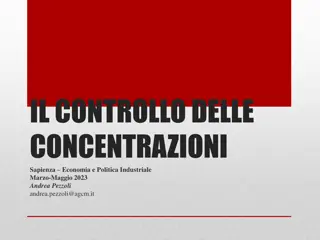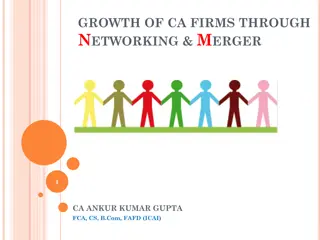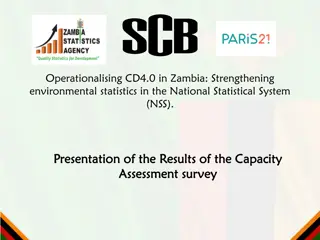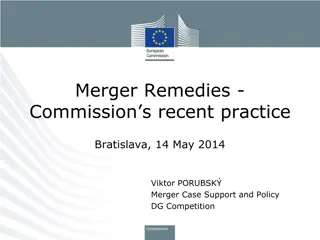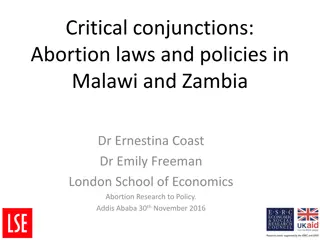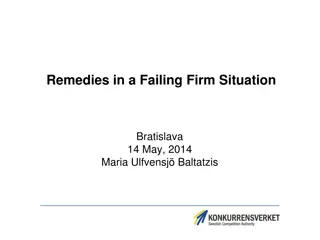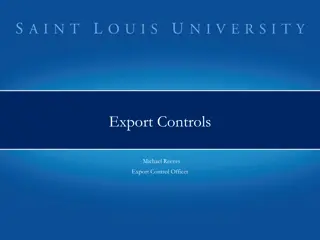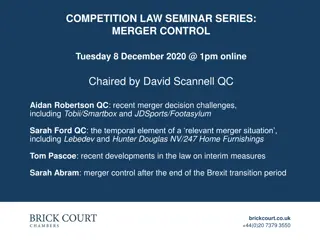Merger Control in Zambia: Regulations and Rationale
The system of merger control in Zambia, established in 1997 under the Competition and Consumer Protection Act, aims to regulate mergers to prevent market dominance and adverse effects on competition. Merger regulation objectives include safeguarding competition, preventing anti-competitive behavior, and ensuring consumer protection. The Competition and Consumer Protection Commission oversees the process, assessing factors such as market concentration, barriers to entry, and competitive effects post-merger. Effective merger control is crucial to maintaining a competitive business environment and protecting consumer interests.
Download Presentation

Please find below an Image/Link to download the presentation.
The content on the website is provided AS IS for your information and personal use only. It may not be sold, licensed, or shared on other websites without obtaining consent from the author. Download presentation by click this link. If you encounter any issues during the download, it is possible that the publisher has removed the file from their server.
E N D
Presentation Transcript
UNIT 5 UNIT 5- - MERGER CONTROL MERGER CONTROL Introduction A system of merger control came into operation in Zambia in 1997. It is governed by Part IV of the Competition and Consumer Protection Act. It is supplemented by:- the Competition and Consumer Protection (General) Regulations Statutory Instrument No.97 of 2011; and the Competition and Consumer Protection Commission Guidelines for Merger Regulations, 2015.
MERGER CONTROL MERGER CONTROL Rationale for Regulation Mergers can give rise to market dominance Preventing companies from gaining market dominance is therefore the most important objective. What's the big deal? Competitors might object to a merger because it could make it hard for them to compete. consumers may also oppose a merger which results in higher prices, or lower quality products Finally, governments may find mergers controversial because they conflict with industrial or foreign policy
MERGER CONTROL MERGER CONTROL Rationale for Regulation Merger regulation therefore aims to prevent a transaction from adversely affecting competition before it is consummated. Why is this important? This is important because it is expensive to undo a harmful merger after it has already taken place Merger regulation may also involve other considerations, like industrial or foreign policy.
MERGER CONTROL MERGER CONTROL Rationale for Regulation The Commission has power under the Act to prevent mergers that are likely to reduce competition and lead to higher prices, lower quality goods or services, or less innovation. A market analysis is carried out to ascertain the market power of the merged entity and the competitive effects of the transaction.
MERGER CONTROL MERGER CONTROL Rationale for Regulation The most important factors in assessing the effects of the merger on competition are:- the degree of concentration, barriers to entry, and the extent to which effective competition would remain in the market after the merger The principle issue is whether a merger has or is likely to have anti- competitive effect in Zambia.
MERGER CONTROL Merger Definition Mergers are ordinarily understood as one company acquiring the assets and liabilities of another company, and causing that other company to cease to exist as an independent entity (Richard Whish, Competition Law, (Oxford University Press, 6th ed, 2009), 798) However, merger is used in a wider sense in competition law, and includes:- amalgamation, pooling of resources in joint ventures, acquisition of another enterprise s shares, voting rights, assets, or control over that enterprise.
MERGER CONTROL Merger Definition S.24(1) CCPA a merger occurs where an enterprise, directly or indirectly, acquires or establishes, direct or indirect, control over the whole or part of the business of another enterprise, or when two or more enterprises mutually agree to adopt arrangements for common ownership or control over the whole or part of their respective businesses.
MERGER CONTROL Merger Definition How can a merger be achieved? S.24(2) a) where an enterprise purchases shares or leases assets in, or acquires an interest in, any shares or assets belonging to another enterprise; a) where an enterprise amalgamates or combines with another enterprise; or a) where a joint venture occurs between two or more independent enterprises.
MERGER CONTROL Control Mergers cause a change in control, which enables one business to effectively control another formerly independent business. Under what circumstances can a business exercise control over another? A person will exercise control of another business where he can influence decision making in that business s affairs or administrative activities. see S. 24(3)
MERGER CONTROL Types of Mergers Mergers are classified based on the position of merging parties prior to the merger. Thus, mergers can be horizontal, vertical or conglomerate. Vertical and conglomerate mergers are referred to as non horizontal mergers. This classification may become important when assessing the effects mergers have on competition.
TYPES OF MERGERS TYPES OF MERGERS Horizontal Merger The most common type of merger Occur when competitors operating on the same market level for the same product combine. Ex. Acquisition of Finance Bank by Atlas Mara These harm competition more than other types of merger. Why? they reduce the number of market players, and increase the market share of the merged entity The merged entity may therefore achieve or strengthen a dominant position.
TYPES OF MERGERS TYPES OF MERGERS Horizontal Merger What if the merger does not create a dominant position? The merger will still reduce competition, because it will increase market concentration, and may therefore allow for anticompetitive coordinated effects. When does coordinated effects arise? Where the merger reduces competitive constraints, allowing companies to coordinate their competitive behavior. Coordination can involve companies creating a collective dominant position
TYPES OF MERGERS TYPES OF MERGERS Vertical Merger Vertical mergers occur when two entities which operate at different but complimentary levels of the production chain combine. Ex. a merger between a raw material supplier and a manufacturer of a final product from that raw material Vertical mergers may involve:- backward integration:- where a company purchases another company at an earlier stage in the production chain, or Forward integration:- where a company purchases a company at a later stage of the production
TYPES OF MERGERS TYPES OF MERGERS Vertical Merger Vertical mergers do not pose as much of a danger to competition as horizontal mergers Can be beneficial. How? by facilitating long term investment, enhancing the quality of the product, and creating efficiencies by reducing transaction cost may also help firms compete with monopolists or vertically integrated competitors However, vertical mergers may also harm competition by foreclosing rivals vertical mergers may also harm competition by allowing companies to coordinate.
TYPES OF MERGERS TYPES OF MERGERS Conglomerate Merger involves a merger between entities in unrelated markets. Conglomerate mergers are divided into the following: 1. pure conglomerate mergers, where merging entities are not connected in any manner; product extension mergers, where the acquiring entity s product is complementary to acquired entity s product; and market extension mergers, where the merging entities seek to enter a new market. 2. 3.
TYPES OF MERGERS TYPES OF MERGERS Conglomerate Merger Conglomerate mergers are also less likely to harm competition than horizontal mergers. However, conglomerate mergers can threaten competition in a number of way. Firstly, they may allow companies to dominate markets in various portfolios of products. Secondly, they may lead to anticompetitive practices like tying and predation. Thirdly, they may lead to coordinated behavior.
JOINT VENTURES JOINT VENTURES Definition The Act does not define a joint venture A joint venture may be defined as:- Any arrangement whereby two or more parties co-operate in order to run a business or to achieve a commercial objective. each enterprise must make a substantial contribution to the implementation of a common project, it must be a separate business usually a separate legal entity but is jointly owned and controlled by the parent enterprises
JOINT VENTURES JOINT VENTURES How does competition law treat Joint Ventures? Competition authorities and academics globally disagree about whether merger regulation should also regulate joint ventures. S.24 (2) CCPA A merger can be achieved where a joint venture occurs between two or more independent enterprises Different jurisdictions use merger regulation to regulate joint ventures in different ways.
JOINT VENTURES JOINT VENTURES How does competition law treat Joint Ventures? In Zambia not all JVs are subject to merger control. Full function joint ventures which meet threshold criteria must be notified to the Commission as a merger. For a joint venture to be fully functional, it must:- 1) be jointly controlled, 2) have sufficient assets and financial resources to operate its business autonomously, and 3) exist for long enough to bring about a lasting change in the relevant market. The Commission may assess a joint venture which does not fulfil the above criteria as an agreement which may be anticompetitive under S.8 CCPA
MERGER CONTROL Reviewable mergers There are two ways in which a merger can be subject to review under the Act. a) the merger meet the threshold limit S. 26 a) On the basis of other grounds S. 27
Reviewable mergers Threshold Limits Threshold limits determine which transactions are notified to and reviewed by competition authorities. Threshold limits allow competition authorities to ignore small mergers which are unlikely to affect competition, and focus only on mergers which are likely to harm competition Different jurisdictions use different threshold limits The companies involved should have sufficient assets or sales within the country s territorial limits for the Commission to have jurisdiction.
Reviewable mergers Threshold Limits Section 25(1) CCPA Parties to a merger transaction that meets the prescribed threshold under subsection (5) shall apply to the Commission for authorisation of the proposed merger The notification threshold is set by the Minister on the recommendation of the Commission. The threshold applies to the combined turnover or assets, whichever is higher in Zambia of the merging parties . The combined assets or turnover, whichever is higher must be atleast fifty million fee units in their latest financial year. See Regulation 8 of SI 97 of 2011 Mergers that are below the prescribed notification threshold are not notifiable with the Commission. -
Reviewable mergers Other grounds of Review Where a proposed merger is below the threshold limit the commission may nonetheless if the Commission has reason to believe the merger could substantially lessen competition in a relevant market. (See S. 27 CCPA) This will occur if:- a) the merger is likely to create a position of dominance in a localised product or geographical market; b) the merger is likely to contribute to the creation of a dominant position through a series of acquisitions which are not individually subject to prior notification; c) the merger may substantially prevent or lessen competition; d) the merger is concluded outside Zambia and has consequences in Zambia that require further consideration; or e) as a result of the merger, there is, or is likely to be, competition and public interest factors which require to be considered.
Reviewable mergers Negative Clearance (S. 28) Section 2 CCPA defines Negative Clearance as the certification by the Commission that an otherwise anti-competitive conduct can be allowed under conditions specified by the Commission. In terms of merger control Section 28 CCPA applies. It is procedure whereby the Commission issues a decision at the request of an enterprise indicating or confirming that it does not consider that a proposed merger is affected by the requirements under section 26 and 27 of the Act. Negative clearance if granted does not however preclude the commission from reviewing the merger if new information becomes available tending to show that such clearance is not appropriate
MERGER CONTROL Substantive Assessment of Mergers Mergers often have procompetitive as well as anticompetitive effects. Competition authorities must balance these effects when deciding whether to block a merger. The following Assessments are employed by the Commissions. 1. Market Assessment (S.29) 2. Competition Assessment (S.30) 3. Public Interest Assessment _(s.31)
MERGER CONTROL Market Assessment The Commission must carry out a market assessment of the proposed merger to determine the likely effects of the proposed merger in the relevant market. The Commission is supposed to define a market for the purposes of either a horizontal merger, and/or for some other mergers This assessment focuses on whether the proposed transaction will confer Market Power upon the newly merged company on the relevant Market. The Commission is supposed to check relevant product and geographic markets
MERGER CONTROL Competition Assessment The Commission will assess whether the merger is likely to prevent or substantially lessen competition on the relevant market in Zambia the Commission shall take into account: the levels of concentration of players in the relevant market; the creation or strengthening of barriers to market entry; the level of imports in the relevant market; the extent to which there is countervailing buyer or supplier power in the relevant market; the availability of substitute products in the relevant market; the likelihood of the merger removing from the market an existing effective and vigorous competitor; the dynamic characteristics of the market including growth, innovation, pricing and other inherent market characteristics; and the risk that a position of dominance may be abused.
MERGER CONTROL Public Interest Assessment The Commission is required to take into account factors which bears upon the public interest These include:- the extent to which the proposed merger is likely to result in a benefit to the public which would outweigh any detriment attributable to a substantial lessening of competition; the extent to which the proposed merger would, or is likely to, promote technical or economic progress and the transfer of skills, or otherwise improve the production or distribution of goods or the provision of services in Zambia; the saving of a failing firm; the extent to which the proposed merger shall maintain or promote exports from Zambia or employment in Zambia; the extent to which the proposed merger may enhance the competitiveness, or advance or protect the interests, of micro and small business enterprises in Zambia;
MERGER CONTROL Period allowed for Substantive assessment( s.32) Determination of proposed merger (s.34) Revocation of merger ( s.35) Offences relating to mergers





